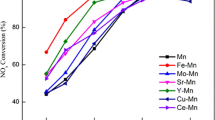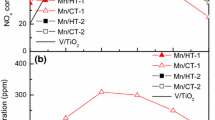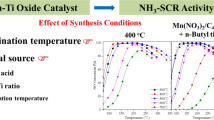Abstract
The effects of different manganese precursors on the low-temperature (100–300 °C) selective catalytic reduction of nitrogen oxide (NOx) were investigated. MnOx/TiO2 catalysts were prepared by a sol–gel method using three different precursors, manganese(II) nitrate (MN), manganese(II) acetate (MA2), and manganese(III) acetate (MA3). They had an overall high specific surface area, but the relatively small surface areas of MN–MnOx/TiO2 and MA3–MnOx/TiO2 were due to the existence of a Mn3O4 phase in these catalysts. There is no chemical reaction at the working temperature, which proves the high thermal stability of all the catalysts. The result of de-NOx (removal of NOx) efficiency in the low temperature region showed that the catalyst synthesized with manganese acetate had higher catalytic activity than the catalyst synthesized with manganese nitrate. Despite the relatively small surface area, the MA3–MnOx/TiO2 exhibited the highest de-NOx efficiency, which resulted from the most enriched Mn concentration and Mn4+ species (MnO2) as well as strong acid sites on catalyst surface.
Similar content being viewed by others
Explore related subjects
Discover the latest articles, news and stories from top researchers in related subjects.Avoid common mistakes on your manuscript.
Introduction
The selective catalytic reduction (SCR) of NOx with NH3 is an effective technique for removing NOx from flue gases of stationary sources [1, 2]. The commercial catalyst, V2O5/TiO2 (anatase) with either WO3 or MoO3, has high activity and stability for the use in SCR of NOx with NH3 at 300–400 °C [3–5]. However, SO2 and the high concentrations of ash in the flue gas reduce their performance and durability because this type of catalyst is always placed before dust precipitation and flue gas desulphurization system [6, 7]. Therefore, the trend is to develop low-temperature catalysts capable of working at the end of the exhaust system without the reheating [8].
In the low temperature SCR, the commercial catalyst cannot be defined. Most of the investigated catalysts were noble metal and transition metal oxides (Cr, Mn, Fe, Co, Ni, and Cu). The research of noble metal catalyst was focused on the catalyst support such as SiO2, Al2O3 [9], mesoporous silica [10], zeolites [11], TiO2–ZrO2 [12], and MgO–CeO2 [13]. It was reported that 50 and 75 % NO conversions were obtained over Pt/Al2O3 catalyst at 140 °C and over Pt/SiO2 catalyst at 90 °C [14]. A large number of catalysts consisted of various transition metal (Cr, Mn, Fe, Co, Ni, and Cu) oxides on different commercial supports have been investigated for low temperature SCR reactions, which can be capable of operating in the temperature range 100–300 °C. Among all the zeolite-based catalysts, Fe-ZSM-5 and Cu-ZSM-5 have been the most extensively investigated in the past 20 years. At temperatures over 350 °C on 2.5 % Fe/ZSM-5, the NO conversion reached nearly 90 % and also with a wide temperature window [15, 16]. Manganese oxides supported on TiO2 have relatively high activity for low temperature SCR of NOx with NH3 among these catalysts [17]. Manganese oxide was the main catalyst (active phase) and titanium oxide was the catalyst support in this composite. The active phase acts as a decomposition catalyst of the nitrogen oxide (NOx) to nitrogen and water. The catalyst support formed a large surface area and ensured that the shape of the active phase was maintained. Titanium oxide does not have activity in the SCR reaction [18]. It has been documented that MnOx–Al2O3 prepared using the manganese acetate (MA) precursor shows better dispersion of MnOx on alumina and higher catalytic activity than manganese nitrate (MN) at 100-180 °C [19]. It has also been reported that the MnOx/TiO2 catalyst prepared from MN resulted in a better performance than that prepared from the MA precursor at 100–200 °C [20].
In this study, commonly used precursors [manganese(II) acetate, manganese(III) acetate, and manganese(II) nitrate] were chosen for the synthesis of MnOx/TiO2 catalysts but the manganese(III) nitrate was excluded from the comparison because manganese(III) nitrate is an unstable compound, which evolves N2O4 at room temperature due to the low thermal stability [21]. The activity of the catalysts synthesized by different precursors were analyzed based on the assumption that the same synthesis condition. Three kinds of the catalyst were characterized by structural and thermal analysis. The effects of the manganese precursors on the catalytic activity were identified in terms of surface chemical properties.
Experimental
Catalyst preparation
The MnOx–TiO2 catalysts were prepared by a sol–gel method with different precursors, manganese(II) nitrate (Mn(NO3)2, MN), manganese(II) acetate (Mn(CH3COO)2, MA2), and manganese(III) acetate (Mn(CH3COO)3·2H2O, MA3). A mixture of titanium(IV) isopropoxide (Ti[OCH(CH3)2]4) and ethanol at a 1:10 (by weight) ratio was stirred under reflux at room temperature. A large amount of deionized water and manganese precursors, which are designated as MN, MA2 and MA3, were added and stirred for 24 h. The sol–gel solution was then vaporized at 110 °C until a dry gel was obtained and treated thermally at 400 °C for 2 h. The heating rate was 5 °C/min to promote the decomposition of organic components in the precursor.
Characterization of the catalysts
The specific surface areas of the catalysts were measured by nitrogen adsorption at liquid N2 temperature (−196 °C), using an ASAP2010 (Micromeritics, USA) adsorption apparatus. Powder X-ray diffraction (XRD) measurements were carried out with a M18XHF (MAC Scientific Co., Netherlands) system with Cu Kα (λ = 0.1543 nm) radiation. A SDTQ600 (TA Instruments, USA) performed to test the thermal analysis. The samples were heated from room temperature to 700 °C at a rate of 10 °C/min. Fourier transform infrared spectroscopy (FT-IR) monitoring of ammonia adsorption was carried out on a Thermo Nicolet 6700 FT-IR instrument (Thermo Electron Corporation, USA) running at a 4 cm−1 resolutions. A gas containing 1000 ppm NH3 (100 ml/min) was passed through the sample for 1 h at room temperature before the FT-IR experiment. The IR spectra were collected after being purged with N2 flow gas for 1 h. The atomic surface concentration on each catalyst was analyzed by X-ray photoelectron spectroscopy (XPS, Escalab 250 (Thermo Scientific, UK) using Al Kα (1486.6 eV) as the radiation source. The reference used the C1s binding energy (BE) of 284.6 eV.
Catalytic activity measurement
The SCR activity was measured in a fixed-bed reactor containing 0.50 ml catalyst at 100–300 °C in 50 °C steps with a gas hourly space velocity of 12,000 h−1. The feed gas mixture consisted of 1000 ppm NO, 1000 ppm NH3, and 5 % O2. A total flow rate of 100 ml/min was maintained for all the experiments with N2 as the balance gas. The flow rate was controlled using a mass flow controller (Sierra Instruments, Inc. and Hi-Tec Co.). The NO and NO2 concentrations were monitored continually using a NOx analyzer (42C, Thermo Ins.). An ammonia trap containing a boric acid solution was installed before the sample inlet to the analyzer to avoid errors due to the oxidation of ammonia in the converter of the NO/NOx analyzer.
Results and discussion
Fig. 1 shows the XRD patterns of the catalysts prepared from different precursors. The peaks corresponding to the TiO2 anatase phase were observed on all samples and Mn3O4 phase was noted on the MN–MnOx/TiO2 and MA3–MnOx/TiO2 samples. The manganese oxide phase was not identified at the MA2–MnOx/TiO2 sample in the XRD pattern. It was originated from the strong background of TiO2 and also implies that manganese oxides could have been in a highly dispersed state or manganese ions were inserted into the TiO2 lattice resulting in the presence of more surface hydroxyl groups in the TiO2 anatase [22–24]. The surface areas of MN-MnOx/TiO2, MA2-MnOx/TiO2 and MA3-MnOx/TiO2 were 161.32, 174.38, and 155.36 m2/g. The MN-MnOx/TiO2 and MA3-MnOx/TiO2 had a small surface area due to the existence of a Mn3O4 phase in these catalysts compared to MA2-MnOx/TiO2.
Fig. 2 shows the results of thermal analysis on MnOx/TiO2. As for MN–MnOx/TiO2 and MA2-MnOx/TiO2, there are two peaks at around 100 and 680 °C. The peak observed at approximately 100 °C, which was due to the evaporation of water [25]. The sharp peak at around 680 °C can be explained by an anatase to rutile phase transformation. However, the chemical reactions including critical weight loss with exothermic peaks cannot be found at working temperatures. It means that materials were chemically stable at the working temperature. The thermal stability in low temperature SCR was important for long term use and the TG/DSC results proved that all samples was suitable as a low temperature SCR catalyst.
Fig. 3 presents the FT-IR spectra of ammonia adsorbed on MnOx/TiO2 catalysts. Two strong peaks at 1667 and 1256 cm−1 and a weaker peak at 1460 cm−1 were observed. The bands at 1667 and 1460 cm−1 were assigned to the symmetric and asymmetric bending vibrations of NH4 + chemisorbed on the Brønsted acid sites, whereas the bands at 1256 cm−1 were assigned to vibrations of the N–H bonds in NH3 linked coordinately to the Lewis acid sites [26–28]. The peak at approximately 1530 cm−1 was attributed to amide (NH2) species. The broad band in the range of 3200–3450 cm−1 was assigned to the O–H and N–H stretching vibration, indicating the coordination adsorption of H atom and O atom in metal oxide appear on the catalyst surface [29–31]. For all the peaks, both the peaks of NH3 adsorption on Brønsted acid sites and Lewis acid sites were obviosuly observed. The MA2-MnOx/TiO2 and MA3-MnOx/TiO2 catalysts have similar acid sites. The adsorption of ammonia on the MN-MnOx/TiO2 catalyst showed relatively weaker acid sites and amide species.
Manganese supported TiO2 catalysts were examined by XPS to identify the surface atomic concentration and the valence states of Mn interacting with TiO2 on each catalyst. Fig. 4 shows the Mn 2p photoelectron peaks of the MnOx/TiO2 catalysts, and Table 1 lists the relative atomic proportion of Mn and the compositions determined by XPS. Two main peaks due to Mn 2p3/2 and Mn 2p1/2 were observed at around 641–653 eV for all samples. The overlapping Mn 2p3/2 peaks were deconvoluted into several peaks with the use of Shirley type background to identify the surface manganese oxide phases and the results are shown in Table 1. It has been well established that the 2p3/2 binding energy of the MnO2 (Mn4+) peak and Mn2O3 (Mn3+) peaks appear at 642.1 ± 0.2 and 641.3 ± 0.2 eV, respectively [19, 20, 32]. The SCR of NO over the pure manganese oxides at the low temperature was investigated by Kapteijn et al. [19] and found that the de-NOx efficiency decreased in the order of MnO2 > Mn5O8 > Mn2O3 > Mn3O4. The MA3-MnOx/TiO2 catalyst had the most enriched Mn concentration and Mn4+ species (MnO2) on the TiO2 surface. In addition, the MA3-MnOx/TiO2 has the highest concentration of Mn on the surface and the Mn/Ti ratio was MA3-MnOx/TiO2 > MA2-MnOx/TiO2 > MN-MnOx/TiO2. It is well-known that the concentration of Mn on the surface was in the same sequence of the catalytic activity.
The catalytic activity of various manganese precursors on the Mn loaded TiO2 catalysts were tested for low temperature SCR from 100 to 300 °C. Fig. 5 presents the NOx conversion results on the above mentioned catalysts. The MnOx/TiO2 catalysts showed over 90 % activity at 200 °C, and saturated from this temperature. The MA3-MnOx/TiO2 catalyst especially showed higher de-NOx efficiency than the others in all regions. The difference in atomic concentration or valence states on the surface was considered. The fact that the MA3–MnOx/TiO2 showed a relatively higher SCR activity despite showing a lower surface area indicates that the surface area is not significant to the low temperature SCR activity. This is caused by the higher Mn coverage resulting in a higher intensity of NH3 adsorption and Mn4+/M3+ ratio. It is easier to understand why the MA3–MnOx/TiO2 catalyst showed better SCR activity because the catalytic reaction is related to the surface MnO2 and NH2 species [6]. The manganese(III) acetate was the most effective precursor for MnOx/TiO2 SCR efficiency for these reasons.
Conclusions
The MnOx/TiO2 catalysts were prepared by a sol–gel method using different precursors for the low temperature SCR. The MN-MnOx/TiO2 catalyst showed relatively weaker acid sites and amide species than the other samples. The MA2-MnOx/TiO2 and MA3-MnOx/TiO2 catalysts contained similar acid sites. The catalyst synthesized with manganese acetate had higher catalytic activity than the catalyst synthesized with manganese nitrate. The MA3-MnOx/TiO2 catalyst especially showed the highest NOx conversion under flow conditions of GHSV = 12,000 h−1 from 100 to 300 °C with a relatively small specific surface area. The MA3-MnOx/TiO2 catalyst was found to be the best for the low temperature SCR of NO with NH3 among the three different types of precursor catalysts examined. The efficiency of MnOx/TiO2 SCR catalyst were able to increase by manganese acetate (III) precursor, because it has enriched Mn concentration and Mn4+ species (MnO2) on the TiO2 surface.
References
Nova I, Ciardelli C, Tronconi E, Chatterjee D, Bandl-Konrad B (2006) Catal Today 114:3–12
Gasagrande L, Lietti L, Nova I, Forzatti P, Baiker A (1999) Appl Catal B Environ 22:63–77
Bosch H, Janssen F (1988) Catal Today 2:369–379
Djerad S, Tifouti L, Crocoll M, Weisweiler W (2004) J Mol Catal A Chem 208:257–265
Ettireddy PR, Ettireddy N, Mamedov S, Boolchand P, Smirniotis PG (2007) Appl Catal B Environ 76:123–134
Kijlstra WS, Brands DS, Poels EK, Bliek A (1997) J Catal 171:208–218
Kijlstra WS, Brands DS, Smit HI, Poels EK, Bliek A (1997) J Catal 171:219–230
Tang X, Hao J, Yi H, Li J (2007) Catal Today 126:406–411
Yokota K, Fukui M, Tanaka T (1997) Appl Surf Sci 121–122:273–277
Wu P, Li L, Yu Q, Wu G, Guan N (2010) Catal Today 158:228–234
Shibata J, Hashimoto M, Shimizu K, Yoshida H, Hattori T, Satsuma A (2004) J Phys Chem B 108:18327–18335
Machida M, Ikeda S, Kurogi D, Kijima T (2001) Appl Catal B 35:107–116
Costa CN, Efstathiou AM (2007) Appl Catal B 72:240–252
Burch R, Coleman MD (1999) Appl Catal B 23:115–121
Granger P, Parvulescu VI (2011) Chem Rev 111:3155–3207
Brandenberger S, Krocher O, Tissler A, Althoff R (2008) Catal Rev 50:492–531
Smirniotis PG, PenÄ DA, Uphade BS (2001) Angew Chem Int Ed 40:2479–2482
Li P, Xin Y, Li Q, Wang Z, Zhang Z, Zheng L (2012) Environ Sci Technol 46:9600–9605
Kapteijn F, Vanlangeveld AD, Moulijn JA, Andreini A, Vuurman MA, Turek AM, Jehng JM, Wachs IE (1994) J Catal 150:94–104
Peña DA, Uphade BS, Smirniotis PG (2004) J Catal 221:421–431
Johnson DW, Sutton DD (1972) Can J Chem 50:3326–3331
Pecchi G, Reyes P, Lopez T, Gomez R, Moreno A, Fierro JLG (2002) J Chem Technol Biotechnol 77:944–949
Li J, Chen J, Ke R, Luo C, Hao J (2007) Catal Commun 8:1896–1900
Topsoe NY, Topsoe H, Dumesic JA (1994) J Catal 151:226–240
Baolong Z (2003) Appl Catal B Environ 40:253–258
Kung MC, Kung HH (1985) Catal Rev 27:425–460
Belokopytov YV, Kholyavenko KM, Gerei SV (1979) J Catal 60:1–7
Topsøe NY (1991) J Catal 128:499–511
Liettia L, Ramis G, Berti F, Toledo G, Robba D, Busca G, Forzatti P (1998) Catal Today 42:101–116
Matralis H, Ciardelli M, Ruwet M, Grange P (1995) J Catal 157:368–379
Zhu J, Gao F, Dong L, Yu W, Qi L, Wang Z, Dong L, Chen Y (2010) Appl Catal B Environ 95:144–152
Chen Z, Yang Q, Li H, Li X, Wang L, Chi TS (2010) J Catal 276:56–65
Acknowledgments
This work was supported by the National Research Foundation of Korea (NRF) grant funded by the Korea government (MSIP) through GCRC-SOP (No. 2011-0030013). We are also especially appreciative to Ms. Mary Van Tyne for her language editing of the manuscript.
Author information
Authors and Affiliations
Corresponding author
Rights and permissions
About this article
Cite this article
Hwang, S., Jo, SH., Kim, J. et al. Catalytic activity of MnOx/TiO2 catalysts synthesized with different manganese precursors for the selective catalytic reduction of nitrogen oxides. Reac Kinet Mech Cat 117, 583–591 (2016). https://doi.org/10.1007/s11144-015-0948-7
Received:
Accepted:
Published:
Issue Date:
DOI: https://doi.org/10.1007/s11144-015-0948-7









